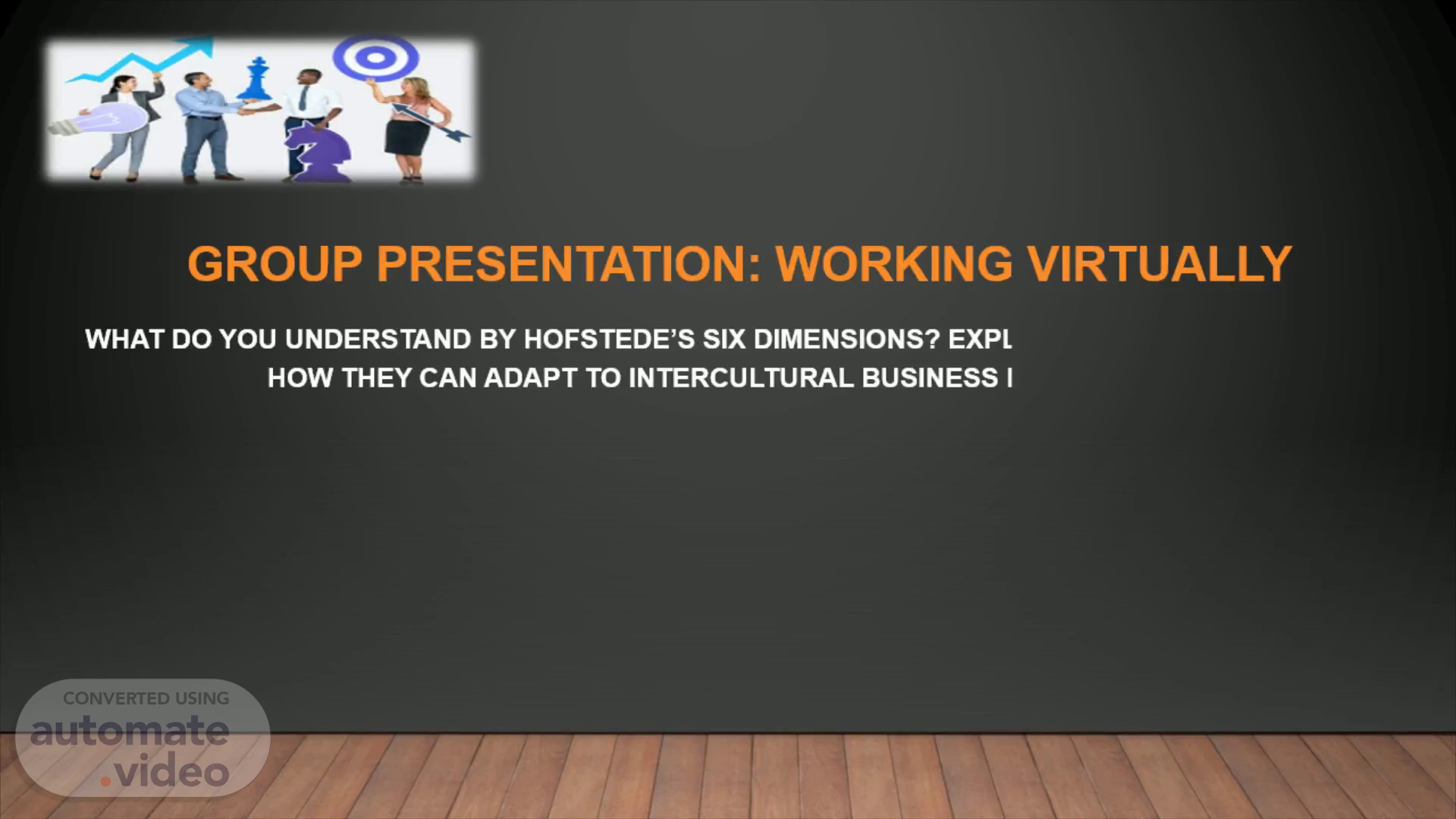
Page 1 (0s)
Group Presentation: Working Virtually. What do you understand by Hofstede’s six dimensions? Explain each dimension and how they can adapt to Intercultural business negotiation.
Page 2 (20s)
Table of Contents. Introduction Background/Overview of Hofstede’s Cultural Dimensions Theory Hofstede’s Six Cultural Dimensions Power Distance Index (PDI) Individualism versus Collectivism (Independently or Interdependently) Masculinity versus Femininity (Assertiveness and Nature Society) Uncertainty Avoidance Index (UAI) Long versus Short Term Orientation ( pragmatic Versus Normative ) Indulgence versus Restraint Conclusion References.
Page 3 (36s)
Introduction. The presentation will focus on analysing and understanding the aspects concerning Hofstede’s cultural dimensions. The presentation will focus on the aspects that support the development of the intercultural business industries. The presentation will focus on identifying the factors that can help to adapt to intercultural business negotiations. The report will explain each dimension of Hofstede’s cultural dimensions to develop a better understanding of intercultural negotiations..
Page 4 (1m 19s)
Background/Overview of Hofstede’s Cultural Dimensions Theory.
Page 5 (2m 12s)
Hofstede’s Six Cultural Dimensions. Power Distance Index (PDI) Individualism versus Collectivisms Masculinity versus Femininity Uncertainty Avoidance Index (UAI) Long versus Short Term Orientation Indulgence versus Restraint.
Page 6 (2m 56s)
Power Distance Index (PDI). High Power Distance Culture Low Power Distance Culture Masses accept unequal power distribution among society ( Vasile , 2016). The junior to senior superiority and obedience is followed and expected. Discrimination is prevalent in almost every sector. Autocratic leadership is seen in this type of power distribution. For example, High power distance cultures can be seen in China, India, Malaysia, and Arab countries. Masses can be seen complaining about the unequal power distribution among the society. Juniors and seniors respect each other. People can be seen raising their voices against discrimination ( Vasile , 2016). A democratic political and organisational leadership can be seen in this type of power distance culture. For example, Low power distance cultures can be seen in the countries such as the UK, Germany, Austria, and New Zealand..
Page 7 (4m 13s)
Individualism versus Collectivism (Independently or Interdependently).
Page 8 (5m 14s)
Masculinity versus Femininity (Assertiveness and Nature Society).
Page 9 (6m 10s)
Uncertainty Avoidance Index (UAI). High Uncertainty Avoidance Low Uncertainty Avoidance People follow rules and regulations to avoid undesirable moments. Following routines and planning becomes a trait for preventing unpredictable moments. People are more traditionalistic, structured and stiff. For example, Russia, Greece, Belgium, Portugal and Japan. People are comfortable with undesirable moments. People can be seen making spontaneous decisions. Relaxed and open-minded people who are bold to encounter unpredictable and uncertain moments. For example, Singapore, Hongkong, Jamaica, Sweden and Denmark..
Page 10 (7m 1s)
Long versus Short Term Orientation ( pragmatic Versus Normative ).
Page 11 (7m 56s)
Indulgence versus Restraint. Indulgence Restraint Perception of control over the personal life Freedom of speech is seen to be important High importance is given to leisure Maintaining order is not given a high priority ( Saorín and Cubillo , 2016). For example, Mexico, Germany, Nigeria, Australia, Canada and Argentina. A perception of limited control over the personal life (helplessness) Freedom of speech is not a priority Lower importance to leisure High importance is given to maintaining order ( Saorín and Cubillo , 2016). For example, Pakistan, Russia, China, Ukraine and Egypt..
Page 12 (8m 55s)
Conclusion. It can be concluded that gaining insights on these dimensions can aid the ability to adapt to the consistently changing behaviours of consumers and organisations. Maintaining a balance between the power distribution index can help incorporate a positive culture for an optimised relation with the stakeholders. It can help add flexibility to the core structure and can evolve the ability to adapt to the intercultural business negotiations by adding more dimensions to the picture..
Page 13 (9m 51s)
References. Caputo, A., Ayoko , O.B., Amoo , N. and Menke, C. (2019) The relationship between cultural values, cultural intelligence and negotiation styles. Journal of Business Research , 99 , pp.23-36. Dinkevych , E., Wilken, R., Aykac , T., Jacob, F. and Prime, N. (2017) Can outnumbered negotiators succeed? The case of intercultural business negotiations. International Business Review , 26 (3), pp.592-603. Le Nguyen, H., Larimo , J. and Ali, T. (2016) How do ownership control position and national culture influence conflict resolution strategies in international joint ventures?. International Business Review , 25 (2), pp.559-568. Minkov , M., Dutt , P., Schachner , M., Morales, O., Sanchez, C., Jandosova , J., Khassenbekov , Y. and Mudd, B. (2017) A revision of Hofstede’s individualism-collectivism dimension: A new national index from a 56-country study. Cross Cultural & Strategic Management . Saorín-Iborra , M.C. and Cubillo , G. (2016) Influence of time pressure on the outcome of intercultural commercial negotiations. Journal of Promotion Management , 22 (4), pp.511-525. Vasile , A.C. (2016) Hofstede’s cultural dimensions and management in corporations. Cross-Cultural Management Journal , 18 (01), pp.35-46..